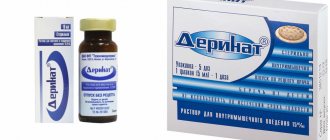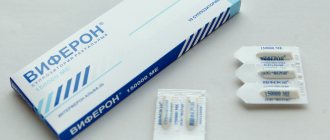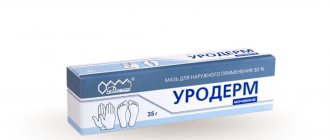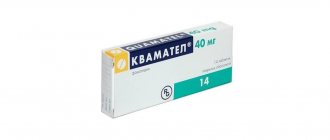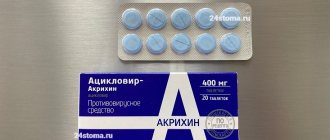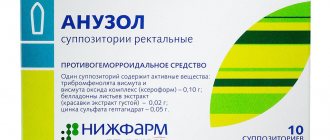Pharmacotherapeutic group: digestive enzyme agent
| Registration number: | LS-000995 |
| International nonproprietary name: | pancreatin |
| Tradename: | micrazim |
| Dosage form: | capsules |
| ATX code: | A09AA02 |
| Active substance | capsules 10,000 units | capsules 25,000 units |
| Pancreatin in the form of enteric pellets | 168 mg | 420 mg |
| containing pancreatin powder | 125 mg | 312 mg |
| which corresponds to activity: | ||
| proteases | 520 units | 1300 units |
| amylase | 7500 units | 19000 units |
| lipases | 10000 units | 25000 units |
Composition per 1 capsule:
| Active substance: | |
| Pancreatin in the form of enteric pellets containing pancreatin powder, which corresponds to the activity: | 672.0 mg 500.0 mg |
| protease amylase lipase | 2080 units 30240 units 40000 units |
Excipients included in the enteric shell of pellets: methacrylic acid and ethyl acrylate copolymer [1:1] (in the form
30% dispersion additionally containing polysorbate-80, sodium lauryl sulfate) - 103.20 mg, triethyl citrate - 20.64 mg, simethicone emulsion 30% dry weight (32.6%) including: dimethicone - 27.8%, silicon colloidal precipitated - 1.3%, colloidal suspended silicon - 0.9%, methylcellulose - 2.5%, sorbic acid - 0.1%, water - 67.4%) - 0.62 mg, talc - 51.70 mg.
Composition of the capsule shell:
body: gelatin – up to 100%, water – 14-15%.
Lid:
gelatin - up to 100%, water - 14-15%, sunset yellow dye - 0.5500%, titanium dioxide - 1.7998%.
"Mikrazim": composition and description
"Micrazim" is a drug administered in the form of gelatin capsules containing powder with granules. The active ingredient is pancreatin, the auxiliary components are gelatin, titanium dioxide, dye and water. The content of pancreatin, depending on the type of drug, is 0-128 mg or 320 mg in 1 capsule.
Sold in cardboard packages of 20 or 50 pcs. in everyone. Available in glass containers or polymer packaging. Should be stored under normal room conditions in a dark place at temperatures up to 25 degrees. Access for children is prohibited. The shelf life is 2 years from the date of production.
Pharmacological properties
Mikrasim® - pancreatin pellets in capsules. The drug contains enzymes - protease, lipase and amylase, which ensure the digestion of proteins, fats and carbohydrates. After taking Mikrasim®, the gelatin capsule dissolves in the stomach within 1-2 minutes, releasing enteric-coated pancreatin pellets. In the stomach, the pellets are quickly and evenly mixed with food and, due to their small size, easily penetrate the duodenum simultaneously with the bolus of food. This ensures the reproduction of the natural digestion process and the maximum speed of onset of the effect.
The acid-resistant shell of the pellets allows the enzymes to be kept completely intact before they begin their work in the intestines, which ensures their maximum digestive activity.
In the small intestine at pH > 5.5, the pellet shell dissolves and at least 97% of the enzymes are released from the pellets within 30 minutes.
Pharmacodynamics
An enzyme preparation that improves food digestion processes in adults and children, and thereby significantly reduces the symptoms of pancreatic enzyme insufficiency, including abdominal pain, flatulence, changes in stool frequency and consistency. Pancreatic enzymes included in the drug facilitate the digestion of proteins, fats and carbohydrates, which leads to their complete absorption in the small intestine. Mikrasim® 40000 contains porcine pancreatin in the form of microgranules, enteric-coated (acid-resistant) in gelatin capsules. The capsules quickly dissolve in the stomach, releasing hundreds of microgranules. This principle was developed with the goal of simultaneous passage (entry) of microgranules with food from the stomach into the intestines and thorough mixing of microgranules with intestinal contents, and, ultimately, better distribution of enzymes after their release within the intestinal contents.
When the microbeads reach the small intestine, the enteric coating is rapidly destroyed (at pH > 5.5), releasing enzymes with lipolytic, amylolytic and proteolytic activity, resulting in the breakdown of fats, carbohydrates and proteins. The resulting substances are then either absorbed directly or further broken down by intestinal enzymes.
Pharmacokinetics
Animal studies have demonstrated a lack of absorption of uncleaved enzymes and, as a consequence, classical pharmacokinetic studies have not been performed. Preparations containing pancreatic enzymes do not require absorption to produce their effects. On the contrary, the full therapeutic activity of these drugs is realized in the lumen of the gastrointestinal tract. Moreover, in their chemical structure they are proteins and, in connection with this, when passing through the gastrointestinal tract, enzyme preparations are broken down until absorption occurs in the form of peptides and amino acids.
Indications for use
Replacement therapy for exocrine (enzyme) pancreatic insufficiency in children and adults, caused by a decrease in the enzyme activity of the pancreas due to impaired production, regulation of secretion, delivery of pancreatic enzymes or their increased destruction in the intestinal lumen, which is caused by a variety of diseases of the gastrointestinal tract, and most often occurring when:
- cystic fibrosis;
- chronic pancreatitis;
- after pancreatic surgery;
- after gastrectomy;
- pancreatic cancer;
- partial gastrectomy (for example, Billroth II);
- obstruction of the pancreatic duct or common bile duct (for example, due to a neoplasm);
- Shwachman-Diamond syndrome;
- condition after an attack of acute pancreatitis and resumption of nutrition.
To avoid complications, use only after consulting a doctor.
Contraindications
- Hypersensitivity to any of the components of the drug.
- Use during pregnancy and breastfeeding
- Pregnancy
There are no clinical data on the treatment of pregnant women with drugs containing pancreatic enzymes. Animal studies have not revealed the absorption of pancreatic enzymes of porcine origin, therefore toxic effects on reproductive function and fetal development are not expected. The drug should be prescribed to pregnant women with caution.
Directions for use and doses
Micrazim® can be prescribed to patients of any age, including infants and the elderly, due to the possibility of individual dose selection by combining drugs with different dosages, as well as due to the ability to use the contents of gelatin capsules (pellets) directly for administration.
Capsules are taken orally, during or after meals, without chewing, with a sufficient amount of liquid (water, juices). If a single dose of the drug is more than 1 capsule, you should take half of the total number of capsules immediately before meals, and the other half during meals. If the single dose is 1 capsule, it should be taken with meals.
If swallowing is difficult (for example, in small children or elderly people), open the capsule and take the drug directly in pellets, after mixing them with a slightly acidic (pH<5.0) liquid or liquid food that does not require chewing (pH<5.0). ). Any mixture of pellets with food or liquid should be consumed immediately after preparation.
When treating with Micrazym®, to prevent increased constipation, it is important to ensure a normal level of water intake, especially with increased fluid loss.
The dose of the drug is selected individually depending on age and severity of symptoms. To achieve an adequate individual dose, in addition to Mikrazim® 40,000 IU capsules, it is possible to use the Mikrazim® drug with dosages of 10,000 IU or 25,000 IU.
Cystic fibrosis
For children over 4 years of age, the average dose is 500 IU of lipase per kilogram of body weight at each meal. For children under 4 years of age, the initial calculated dose is 1000 IU of lipase per kilogram of body weight at each feeding (it is recommended to use the drug Micrasim® 10,000 IU or 25,000 IU)
The dose should be selected individually, depending on the severity of the disease, the severity of steatorrhea and nutritional status. The maintenance dose for most patients should not exceed 10,000 units of lipase per kilogram of body weight per day.
In other conditions accompanied by exocrine pancreatic insufficiency,
the dose is set individually, taking into account the degree of digestive insufficiency and fat content in food, individual eating habits and the patient’s age. The dose of lipase required by the patient during the main meal (breakfast, lunch or dinner) varies from 20,000 units to 75,000 units.
When treated with Mikrasim®, the average initial dose of lipase is 10,000 - 25,000 units during the main meal (provided by using Mikrasim 10,000 units or Mikrasim 25,000 units), however, higher doses may be required to achieve a therapeutic effect. Typically, the patient should receive at least 20,000 IU - 50,000 IU of lipase with food.
In case of severe steatorrhea (more than 15 g of fat in feces per day), in the presence of diarrhea, loss of body weight and no effect of diet therapy, treatment begins with a dosage of 25,000 IU of lipase at each meal, but if necessary and well tolerated, the dose is increased to 35,000 IU — 40,000 units of lipase per dose. Further increase in dose, in most cases, does not improve treatment results and requires a revision of the diagnosis, reduction of fat in the diet and/or additional prescription of drugs - proton pump inhibitors.
The average dose of pancreatin for adults is 150,000 units/day; with complete blockade of the exocrine function of the pancreas - 400,000 units/day, which corresponds to the daily requirement of an adult for lipase.
The maximum daily dose is 15,000 IU-20,000 IU/kg. The permissible dose for children under 1.5 years of age is 50,000 units/day; over 1.5 years - 100,000 units/day.
The duration of taking pancreatin can vary from several days (digestive disorders) to several months or years (long-term replacement therapy).
Special instructions and drug interactions
Before long-term treatment with pancreatin-based drugs (Mikrazim and analogues), a mandatory consultation with a doctor is indicated, especially if taken in high doses. There is no data on addiction to the active ingredients of the drug, as well as on its effect on concentration, the ability to drive a car, or use complex mechanisms.
The drug can be used simultaneously with almost all medications. But if iron is present in the composition (for example, to increase hemoglobin levels), then while taking Microzim it may be absorbed worse, which will weaken the therapeutic effect.
Side effects
Gastrointestinal disorders
Very common (≥1/10): pain in the abdominal area.
Common (≥1/100, <1/10): nausea, vomiting, constipation, bloating, steatorrhea, diarrhea.
Not known: strictures of the ileum, cecum and colon (fibrosing colonopathy). Loss of body weight. Gastrointestinal disorders are mainly associated with the underlying disease. The incidence of adverse reactions such as abdominal pain and diarrhea was lower or similar to that observed with placebo.
Strictures of the ileum, cecum and colon (fibrosing colonopathy) have been observed in patients with cystic fibrosis receiving high doses of pancreatin preparations (see section "Special Instructions").
Skin and subcutaneous tissue disorders
Uncommon (>1/1000, <1/100): rash.
Frequency unknown: itching, urticaria.
Immune system disorders
Frequency unknown: hypersensitivity (anaphylactic reactions, including angioedema).
Allergic reactions were observed mainly from the skin, but other manifestations of allergies were also noted. Reports of these side effects were received during post-marketing use and were spontaneous. There are insufficient data to accurately estimate the incidence of cases.
When used in children, no specific adverse reactions were observed. The frequency, type and severity of adverse reactions in children with cystic fibrosis were similar to those in adults.
Analogues of the drug "Mikrazim"
There are quite a few analogues of Mikrazim. Among them are the following drugs:
- Gastenorm" - tablets made in India, which are prescribed in the presence of chronic pancreatitis, problems with the chewing reflex, and insufficiency of pancreatic function. Compared to Micrazim, Gastenorm is more likely to cause allergic reactions.
- “Mezim Forte 10000” is a well-known drug made in Germany, similar in composition. It is used for heaviness in the abdomen, including due to overeating, as well as for the treatment of digestive disorders, including during operations.
- “Biofestal” is a direct analogue of “Mezim”, it compensates for the lack of digestive enzymes. Compared to Mikrazim, the product is not recommended for use by young children of preschool age.
- “Festal” is an analogue of “Biofestal”, used for the same purposes and in similar dosages.
- "Livonorm" is a biological additive of plant origin. Contains milk thistle extract, a complex of vitamins and other beneficial substances that improve the functioning of the gallbladder.
Release form
Capsules 40,000 units
3, 5 or 10 capsules in a blister pack made of polyvinyl chloride film and printed varnished aluminum foil.
20, 30, 40 or 50 capsules in a polymer jar (made of high-density polyethylene) with a screw-on lid.
1 can or 1, 2, 3, 4, 6, 8 or 10 blister packs of 3 or 5 capsules, or 1, 2, 3, 4, 5, 6, 8 or 10 blister packs of 10 capsules each together with instructions for use are placed in a cardboard pack.
Where to buy Mikrazim: price, reviews
You can buy the product at any pharmacy. The drug is sold freely, without a prescription. The price for a package of 20 capsules is 400-500 rubles, 50 capsules – 750-800 rubles.
Reviews about the drug are almost all positive - more than 90% of buyers recommend it. Among the positive aspects, a quick, noticeable effect, improved digestion, and the absence of side effects and contraindications are noted. Among the disadvantages is the relatively high price. It is also noted that over time, addiction occurs and the therapeutic effect weakens.
